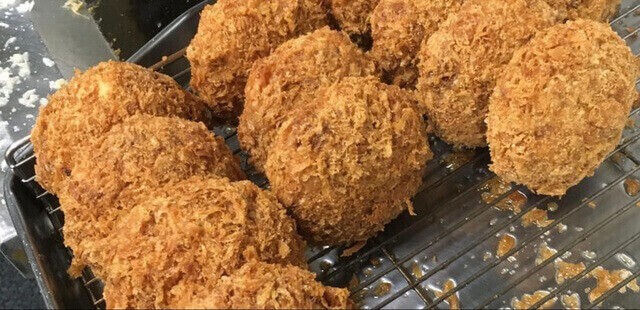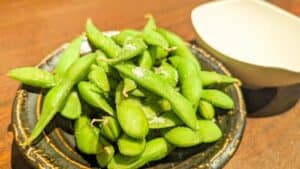If you come to Japan, you can find that Menchi Katsu is sold at almost every supermarket and butcher shop. This dish may be the favourite of a lot of people since they were children. Sometimes it is called “minced katsu”. Which one is correct, menchi katsu or minced katsu? This time, we will explain the origin of the word!
What is Menchi Katsu?
Menchi Katsu, also known as ground meat cutlet, is a Japanese dish that consists of minced pork or beef, finely chopped onions, salt and pepper, etc. into balls, forming them into oval shapes, coating them with batter. It is popular as a trendy B-grade gourmet and local gourmet even if you eat it as a snack. Although locals abbreviated the name as menchi, some locals also called minced cutlet in the area centering on Osaka. Menchikatsu often conveys images of a well-known Western cuisine, however other variations emphasise the utilization of branded meat.
Etymology

There is no clear theory about the etymology of “menchi (メンチ).” A commonly used myth is that “mince meat cutlet (ミンスミートカツレツ)” is a Japanese English word that combines mince (minced meat), meat (meat), and cutlet (originally derived from the French cotelette), and later “mince meat cutlet (ミンスミートカツレツ)” was omitted. There is a popular theory that ‘minsu (ミンス) turned into ‘menchi (メンチ)” in the process and became ‘menchi cutlet (メンチカツ)’. However, there are no documents that support it, and the names have changed too much.
Menchi Katsu History

The Japanese believed that the minced meat cutlet originated in 1897 when locals served this at a Western-style restaurant called Rengatei in Asakusa, Tokyo. The dish was introduced from the Kanto region to the Kansai region and was the second-generation owner of Jun Kobe Meat Mitsuwaya Butcher Shop (founded in 1909, the current Mitsuwaya Sohonten) in Minatogawa, Kobe City, Hyogo Prefecture, in the early Showa period. Mizuno Mitsuji named it with a hint of “meatballs” at a western restaurant in Tokyo.
Menchi Katsu Recipe

Menchi Katsu Ingredients
| Ingredients of Menchi Katsu for 2 persons | |
| Mixed meat | 250g |
| Onion | 150g |
| Carrots | 50g |
| Bread crumbs for batter | 80g |
| Frying oil | 100g |
| Soy sauce or sauce | 30g |
| Egg | 46g |
| Grated garlic | 15g |
| Sake | 14g |
| Salt | 5g |
| Pepper | 3g |
| Flour | 56g |
| Water | 28g |
How to make Menchi Katsu
There are three main ingredients for menchikatsu: minced meat, onions, and carrots. Carrots can be replaced with onions, but carrots are more flavorful and homely delicious.
Combine the onion and minced meat in a bowl, add 1 egg, grated garlic tube, teaspoon salt, sake, and a little pepper, and mix. Then, shape it into a round shape about 1.5 cm thick.
First, before making the batter liquid, put out a lot of bread crumbs. Spread the minced cutlet with bread crumbs on, and take the minced cutlet out of the refrigerator. When that is ready, combine 1 egg, flour, and water in a bowl.
Using your dry hand, place the crumbs over the top and press lightly to stick the crumbs all over. Repeat the tasks one by one. Next, shape it into a round shape, and if there is a place where the bread crumbs are not firmly attached, sprinkle bread crumbs to make them stick.
Heat the frying oil to 160-170°C. Then, gently drop the mince cutlet and fry it for 7 to 8 minutes while turning it over once every 2 minutes.
Serve with shredded cabbage and more, and have it freshly fried. Menchi katsu is delicious with either soy sauce or Worcestershire sauce.
How to eat Menchi Katsu

Japanese locals eat the Menchikatsu with Worcestershire sauce. It is sometimes used as an ingredient in sandwiches and hamburgers. Although it is also considered a light meal, often served with rice or soup as a set meal.
Menchikatsu health info

Menchikatsu contains two major nutrients; proteins, and carbohydrates. The calories and nutrients per 100g of the menchi katsu set meal. Protein is a nutrient that is the material of the body (skeletal muscle and internal organs). Carbohydrates provide fast-acting energy while fats provide long-lasting energy. Excessive intake of any of the two macronutrients is stored in the body as fat.
Menchi Katsu vs Corquette

Both menchi katsu and croquettes are made by rolling the ingredients into oval shapes, coating them with flour, beaten egg, and bread crumbs, and frying them in oil. Mince cutlet is a mixture of minced pork or beef and chopped onions. Croquettes are a mixture of boiled potatoes, stir-fried minced meat, and chopped onions.
Various Menchikatsu
Menchikatsu (pork)

Made with pork which is light yet juicy and is overwhelmingly the most popular.
Menchikatsu (beef)

Made with 100% beef, seasoned with salt and black pepper to bring out the flavor of the meat.
Cheese Menchikatsu

Rich cheddar cheese melts. There is also “W cheese” (270 yen/store limited)
Plum shiso Menchikatsu

Add the refreshing acidity of umeboshi to “shiso menchi”. The sweetness of the meat stands out
Chicken Menchi katsu

A popular dish that uses thigh meat, so it’s soft and juicy.
Miso Menchi katsu

The basic pork is kneaded with a sweet and rich red miso-based homemade sauce.
To note, there are many types of menchikatsu and there exists a menchikatsu that uses premium beef. You can visit Kobe and have a try on their Kobe beef menchikatsu. It is tastier than just normal beef menchikatsu.
Difference between menchi katsu, minced cutlet, and hamburger steak?

Menchi Katsu originated from a western restaurant in Asakusa, Tokyo. From the middle of the Meiji period and uses minced beef/pork and onions as ingredients. They usually dip it in bread crumbs and fry it. Mince cutlets originated from a butcher shop in Hyogo and Kobe. The early Showa era used ground beef and onions as ingredients. Like menchi katsu, locals usually dip it in bread crumbs and fry it. On the other hand, the hamburger steak originating in Germany introduced to Japan. From around Meiji 15 uses ground beef/pork, ground beef only as ingredients. This one uses a different method – baking it on an iron plate or grill.
Where to buy Menchi Katsu
Asakusa Menchi (浅草メンチ)

The menchi katsu, which uses a mixture of ground beef and Koza Pork, which is said to be soft and has good fat, is piping hot in the bag of Asakusa Menchi. The batter, which uses raw bread crumbs, is crispy and light when you take a bite, and the meat juices flow out from inside.
Kameari Menchi (亀有メンチ)

The brothers decided to open a store specializing in menchi katsu, thinking that it would be loved by everyone. More than 8 kinds of minced meat and 4 kinds of sauce. It is a menchi katsu speciality store that pursues minced meat. The basic Kameari menchi cutlet is 100% pork. There is also unusual menchi katsu such as plum shiso, curry, basil chicken, miso, and pickled ginger menchi cutlet.
Sato Kichijoji (吉祥寺さとう)

It’s famous for its menchi katsu, but since it’s a butcher’s shop, they also have side dishes such as grilled pork, croquettes, and kushikatsu. Their famous Ganso Maru menchi. Due to its popularity, you can only buy 20 pieces per person on weekdays and 10 pieces per person on weekends. The menchikatsu is a mixture of several types of wagyu beef, including Matsuzaka beef
Final Thoughts

Since Menchi Katsu is a breaded deep-fried meat, it’s like Tonkatsu and the only difference is that the meat is ground meat. But unlike Tonkatsu, the filling is much softer and easier to bite into. Menchi Katsu is a Japanese yoshoku dish made with minced meat thick patties that are breaded and then deep fried. These patties can be made with either beef, chicken, pork, or any mixture of each. So if you’re craving menchi katsu and happen to spot one, go ahead and try it because it is worth trying.
If you’re wondering if there is a lot of katsu or cutlet in Japan, there are many types such as Tonkatsu, Miso Katsu, and Gyukatsu.
















Comments